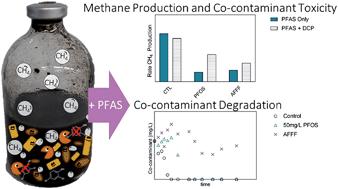当前位置:
X-MOL 学术
›
Environ. Sci.: Processes Impacts
›
论文详情
Our official English website, www.x-mol.net, welcomes your
feedback! (Note: you will need to create a separate account there.)
Aqueous film forming foam and associated perfluoroalkyl substances inhibit methane production and Co-contaminant degradation in an anaerobic microbial community.
Environmental Science: Processes & Impacts ( IF 4.3 ) Pub Date : 2019-08-27 , DOI: 10.1039/c9em00241c Nicole J M Fitzgerald 1 , Hanna R Temme 1 , Matt F Simcik 2 , Paige J Novak 1
Environmental Science: Processes & Impacts ( IF 4.3 ) Pub Date : 2019-08-27 , DOI: 10.1039/c9em00241c Nicole J M Fitzgerald 1 , Hanna R Temme 1 , Matt F Simcik 2 , Paige J Novak 1
Affiliation

|
Aqueous film forming foams (AFFF) can contain gram per liter concentrations of per- and polyfluoroalkyl substances (PFAS) and are often released in large quantities directly to the environment as they are used to fight fires. AFFF composition is complex and contains many unknown PFAS in addition to ingredients such as hydrocarbons, solvents, and corrosion inhibitors. While biological effects of single PFAS have been studied, the effects of PFAS-containing mixtures, such as AFFF, are unknown. The effect of PFAS on microorganisms is also not well understood; nevertheless, we rely on microorganisms in locations containing elevated PFAS concentrations to perform certain functions, such as carbon cycling and co-contaminant degradation. This study focused on determining the functional consequences of AFFF and PFAS exposure in a microbial community in both the presence and the absence of a co-contaminant. AFFF, select PFAS, and a PFAS mixture were tested to determine the effect of AFFF on an anaerobic microbial community and the characteristics of the PFAS that drive toxicity in such mixtures. To study this, anaerobic digester communities were exposed to PFAS and a co-contaminant (2,4-dichlorophenol, DCP); methane production, as an indicator of toxicity and the community's ability to cycle carbon, and co-contaminant degradation were monitored. Results showed that PFAS and AFFF can alter the toxicity of DCP, inhibit DCP degradation, decrease the number of methanogens present, and change the microbial community structure. DCP was also able to decrease the toxicity of the PFAS perfluorooctane sulfonate (PFOS), possibly by changing the sorption of PFOS to the microorganisms present. Additionally, it was determined that while PFOS was responsible for AFFF toxicity, no single PFAS or simple PFAS mixture accurately accounted for the inhibition of DCP degradation caused by AFFF exposure.
中文翻译:

水成膜泡沫和相关的全氟烷基物质可抑制厌氧微生物群落中甲烷的产生和共污染物的降解。
水成膜泡沫(AFFF)可以包含每升浓度的克和全氟烷基物质(PFAS)克,并且通常用于灭火时直接释放到环境中。AFFF的组成很复杂,除了碳氢化合物,溶剂和腐蚀抑制剂等成分外,还包含许多未知的PFAS。虽然已经研究了单一PFAS的生物学作用,但还不清楚含PFAS的混合物(如AFFF)的作用。PFAS对微生物的作用也没有被很好地理解;但是,我们依靠PFAS浓度升高的地方的微生物来执行某些功能,例如碳循环和共污染物降解。这项研究的重点是确定在存在和不存在共污染物的情况下,微生物群落中AFFF和PFAS暴露的功能后果。测试了AFFF,选择的PFAS和PFAS混合物,以确定AFFF对厌氧微生物群落的影响以及在此类混合物中驱动毒性的PFAS的特性。为了研究这一点,厌氧消化器群落暴露于PFAS和一种共污染物(2,4-二氯苯酚,DCP)中。监测了甲烷的产生,以此作为毒性和社区循环碳的能力以及共污染物降解的指标。结果表明,PFAS和AFFF可以改变DCP的毒性,抑制DCP降解,减少存在的产甲烷菌的数量,并改变微生物群落结构。DCP还可能通过改变PFOS对存在的微生物的吸附来降低PFAS全氟辛烷磺酸(PFOS)的毒性。此外,已确定,虽然全氟辛烷磺酸是造成AFFF毒性的原因,但没有单一的PFAS或简单的PFAS混合物能准确解释由AFFF暴露引起的DCP降解的抑制作用。
更新日期:2019-08-27
中文翻译:

水成膜泡沫和相关的全氟烷基物质可抑制厌氧微生物群落中甲烷的产生和共污染物的降解。
水成膜泡沫(AFFF)可以包含每升浓度的克和全氟烷基物质(PFAS)克,并且通常用于灭火时直接释放到环境中。AFFF的组成很复杂,除了碳氢化合物,溶剂和腐蚀抑制剂等成分外,还包含许多未知的PFAS。虽然已经研究了单一PFAS的生物学作用,但还不清楚含PFAS的混合物(如AFFF)的作用。PFAS对微生物的作用也没有被很好地理解;但是,我们依靠PFAS浓度升高的地方的微生物来执行某些功能,例如碳循环和共污染物降解。这项研究的重点是确定在存在和不存在共污染物的情况下,微生物群落中AFFF和PFAS暴露的功能后果。测试了AFFF,选择的PFAS和PFAS混合物,以确定AFFF对厌氧微生物群落的影响以及在此类混合物中驱动毒性的PFAS的特性。为了研究这一点,厌氧消化器群落暴露于PFAS和一种共污染物(2,4-二氯苯酚,DCP)中。监测了甲烷的产生,以此作为毒性和社区循环碳的能力以及共污染物降解的指标。结果表明,PFAS和AFFF可以改变DCP的毒性,抑制DCP降解,减少存在的产甲烷菌的数量,并改变微生物群落结构。DCP还可能通过改变PFOS对存在的微生物的吸附来降低PFAS全氟辛烷磺酸(PFOS)的毒性。此外,已确定,虽然全氟辛烷磺酸是造成AFFF毒性的原因,但没有单一的PFAS或简单的PFAS混合物能准确解释由AFFF暴露引起的DCP降解的抑制作用。











































 京公网安备 11010802027423号
京公网安备 11010802027423号